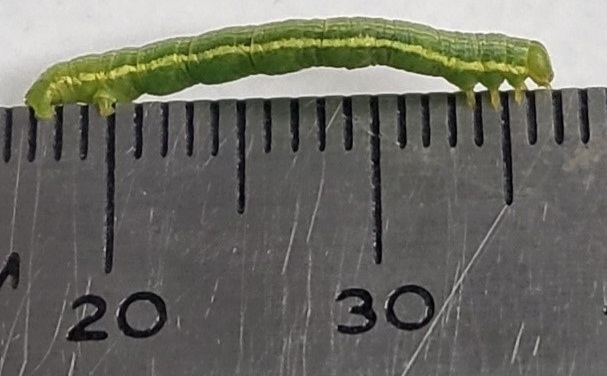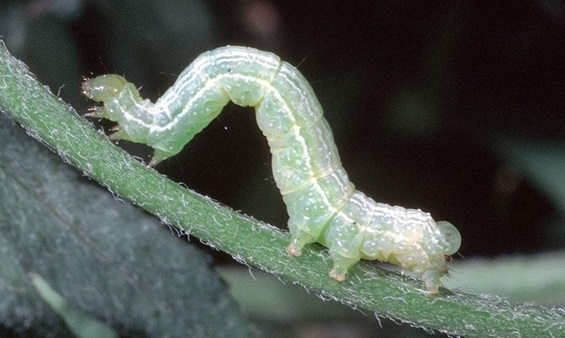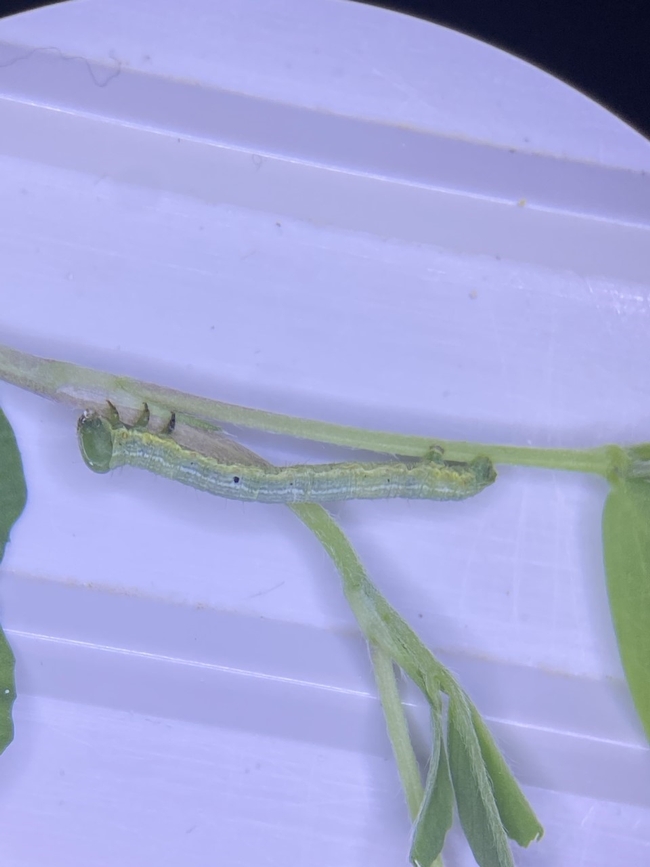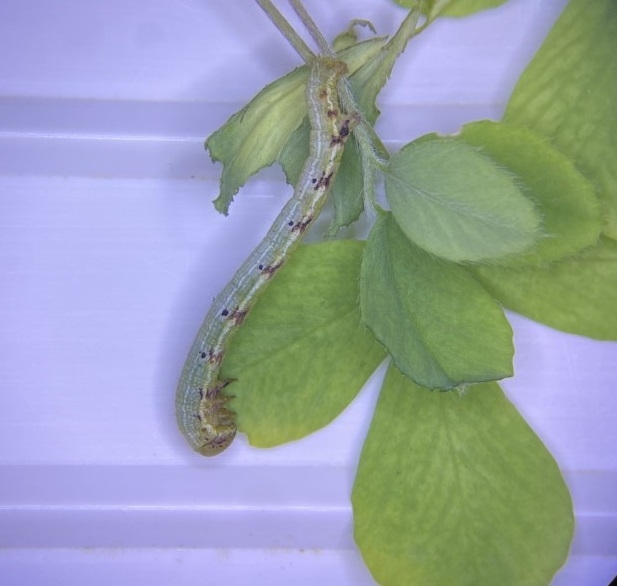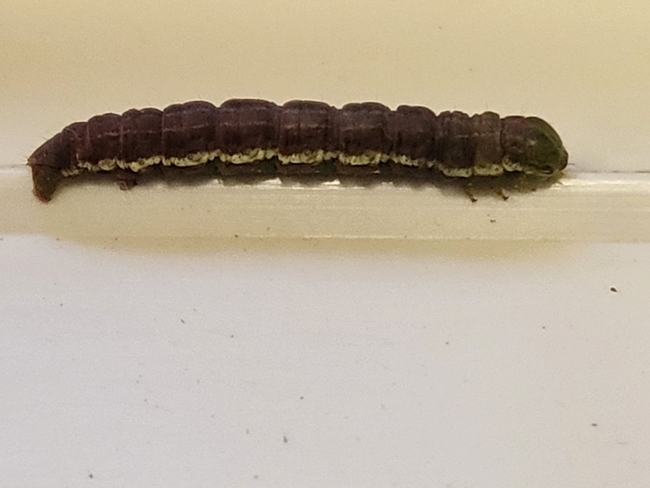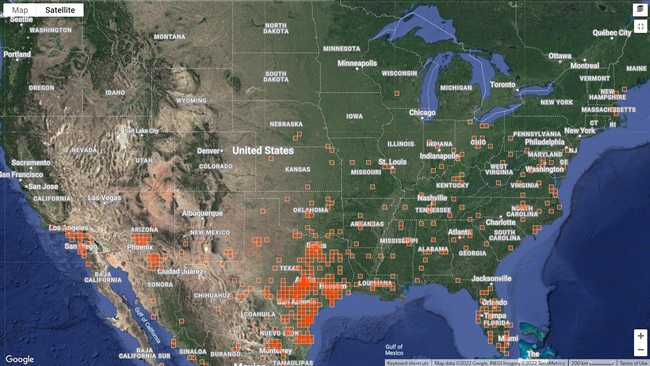A new caterpillar was found this fall on alfalfa in the Palo Verde Valley of California and several other alfalfa growing areas of western Arizona.
Is this a New Pest? The initial finding of the ‘dot-lined angle' caterpillar (moth) was reported to UCCE in mid-October by a highly experienced pest control advisor (Richard Wellman), who had collected it in several fields in the Palo Verde Valley but realized it was an unfamiliar species. UCCE advisor Michael Rethwisch (Riverside County, CA) identified the species as the dot-lined angle (Psamatodes abydata), with this identification confirmed by Marc Epstein at the California Department of Food and Agriculture.
The dot-lined angle has been reported from much of the southern and eastern United States, with moths documented as far north as Wisconsin. This species has not previously been reported feeding on alfalfa, however. The findings of this insect in alfalfa fields in new geographic areas is of note, as it indicates that this caterpillar has now expanded its host plant range to include alfalfa. However, does this constitute a new pest in alfalfa? This is not clear as of now.
What is the threat? The threat this pest it poses to alfalfa production is yet to be determined, but populations as high as 13/sweep were reported from Yuma County, Arizona, by a University of Arizona entomologist. Caterpillars were still being collected from some fields in the Palo Verde Valley in early December, with these ranging from just emerged from eggs to last instar caterpillars.
Dot-lined angle caterpillars are loopers (also known as inchworms), and mature caterpillars are almost one inch long. They are different from cabbage loopers and alfalfa loopers as the latter two species of 2 sets of prolegs in addition to those on the last abdominal segment (three total, Fig. 1), while dot lined angle caterpillars have only 2 total sets of prolegs.
Fig. 1. Dot-lined angle caterpillars have 2 pairs of abdominal prolegs (top) while cabbage and alfalfa loopers have 3 sets of abdominal prolegs (bottom). Dot-lined angle caterpillars bodies are also much thinner than cabbage/alfalfa looper caterpillars. (Photo on left by M. Rethwisch, photo on right by UC-ANR)
Different Stages of Development. The larval stages of the dot lined angle are somewhat unusual, as they change from instar to instar. Early instars have green heads, are light green and have multiple white stripes (Fig. 2). Later instars caterpillars have a series of lined dots on each side (Fig. 3). This feature is likely the reason for the name (dot lined) although most literature also mentions dots on the adult moth.
Fig. 2. Early instar dot-lined angle caterpillar does not have prominent dots (Photo by Sarah Unzon Gonzalez, UCCE-Riverside County, Palo Verde Valley office)
Fig. 3. Later instar dot lined angle caterpillar shown feeding on alfalfa. A series of dots is easily noted, and is often accompanied by additional dark coloration below each dot. (Photo by Sarah Unzon Gonzalez, UCCE-Riverside County, Palo Verde Valley office)
Last instar caterpillars look quite different than early-instar caterpillars. They are no longer green but have a dark appearance, with coloration ranged from dark brown (Fig. 4) to a faint pink.
Fig. 4. Last instar dot-lined angle caterpillar. This stage looks very different than previous instars, This particular specimen is darker colored than most at this stage of development. (M. Rethwisch, photo)
The adult moth Dot-lined Angle moth has a distinct angle in the middle of the hind wing (Fig. 5), rather than being rounded as noted with most moths. As can be seen and adult moth has lines across the wings, and usually has a dot in the line on the hind wing.
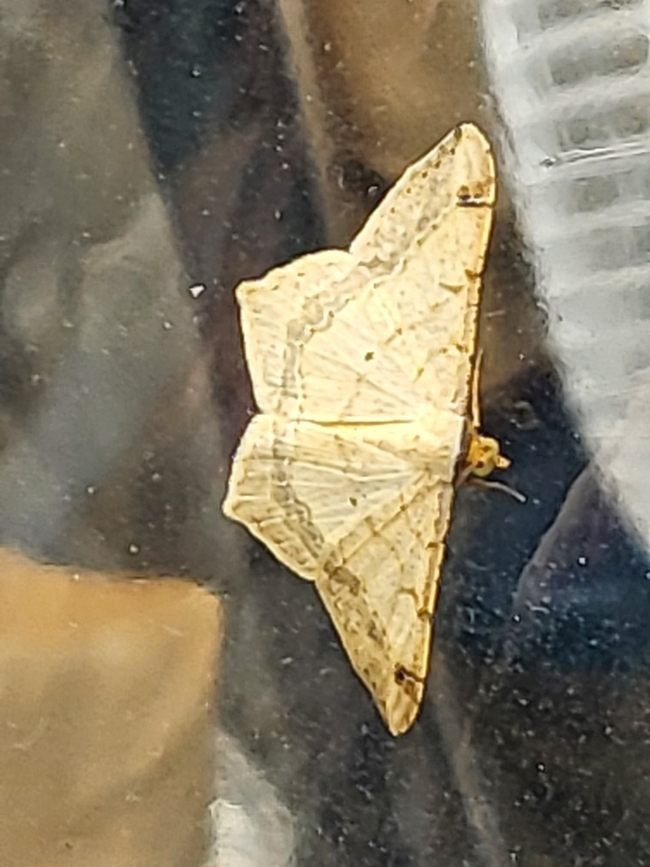
Fig. 5. Adult dot lined angle moth (M. Rethwisch, photo)
Feeding on Alfalfa is New. The important thing to realize is that while the dot-lined angle is not new to the US or to California (Fig. 6), feeding on alfalfa is new to us and is significant as it represents a host plant expansion. The potential damage to alfalfa is unknown due to the newness of this host plant adaptation. Most previously reported host plants had been other legumes such as soybean, leuceana and Sesbania.
Fig. 6. U.S. distribution map of dot lined angle (from iNaturalist - https://www.inaturalist.org/guide_taxa/544921)
FEEDBACK REQUESTED
If you have observed the 'dot-lined angle' potential pest in alfalfa fields in your region, please post your notes below in this blog, and contact your Farm Advisor, entomologist, or M. Rethwisch at UCCE Riverside County, CA.
Author - Field Crops University of California Cooperative Extension Farm Advisor Palo Verde Valley Vegetables
